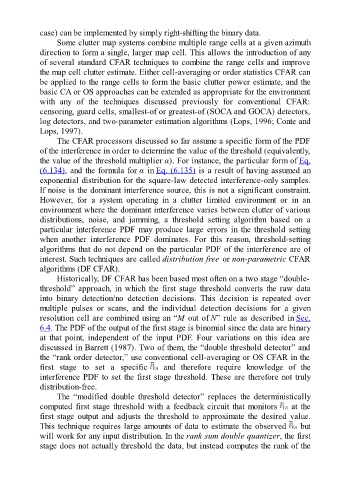Page 533 - Fundamentals of Radar Signal Processing
P. 533
case) can be implemented by simply right-shifting the binary data.
Some clutter map systems combine multiple range cells at a given azimuth
direction to form a single, larger map cell. This allows the introduction of any
of several standard CFAR techniques to combine the range cells and improve
the map cell clutter estimate. Either cell-averaging or order statistics CFAR can
be applied to the range cells to form the basic clutter power estimate, and the
basic CA or OS approaches can be extended as appropriate for the environment
with any of the techniques discussed previously for conventional CFAR:
censoring, guard cells, smallest-of or greatest-of (SOCA and GOCA) detectors,
log detectors, and two-parameter estimation algorithms (Lops, 1996; Conte and
Lops, 1997).
The CFAR processors discussed so far assume a specific form of the PDF
of the interference in order to determine the value of the threshold (equivalently,
the value of the threshold multiplier α). For instance, the particular form of Eq.
(6.134), and the formula for α in Eq. (6.135) is a result of having assumed an
exponential distribution for the square-law detected interference-only samples.
If noise is the dominant interference source, this is not a significant constraint.
However, for a system operating in a clutter limited environment or in an
environment where the dominant interference varies between clutter of various
distributions, noise, and jamming, a threshold setting algorithm based on a
particular interference PDF may produce large errors in the threshold setting
when another interference PDF dominates. For this reason, threshold-setting
algorithms that do not depend on the particular PDF of the interference are of
interest. Such techniques are called distribution free or non-parametric CFAR
algorithms (DF CFAR).
Historically, DF CFAR has been based most often on a two stage “double-
threshold” approach, in which the first stage threshold converts the raw data
into binary detection/no detection decisions. This decision is repeated over
multiple pulses or scans, and the individual detection decisions for a given
resolution cell are combined using an “M out of N” rule as described in Sec.
6.4. The PDF of the output of the first stage is binomial since the data are binary
at that point, independent of the input PDF. Four variations on this idea are
discussed in Barrett (1987). Two of them, the “double threshold detector” and
the “rank order detector,” use conventional cell-averaging or OS CFAR in the
first stage to set a specific and therefore require knowledge of the
interference PDF to set the first stage threshold. These are therefore not truly
distribution-free.
The “modified double threshold detector” replaces the deterministically
computed first stage threshold with a feedback circuit that monitors at the
first stage output and adjusts the threshold to approximate the desired value.
This technique requires large amounts of data to estimate the observed but
will work for any input distribution. In the rank sum double quantizer, the first
stage does not actually threshold the data, but instead computes the rank of the

